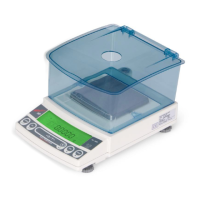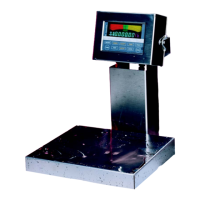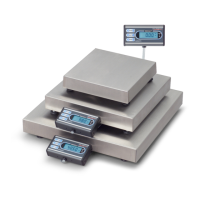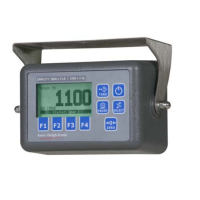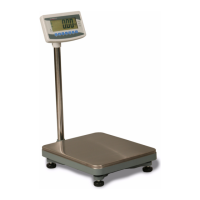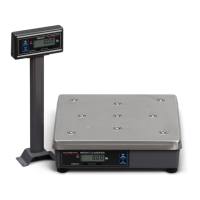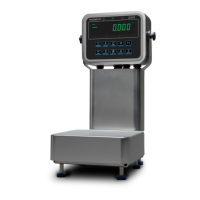Do you have a question about the Avery Weigh-Tronix HC12000 and is the answer not in the manual?
Instructions for operating the electronic balance.
Details on manufacturer, EC directives, and standards compliance.
Explains CAUTION, Note, and other symbols used in the manual.
Precautions for installation, AC adapter use, and peripherals.
Identification of the main parts of the balance unit.
Explains the functions of the balance's main unit keys.
Explains the meaning of various symbols displayed on the balance screen.
Covers selecting a site and installing the balance.
Steps for turning on the balance and fitting accessories.
How to set the clock and perform span calibration.
Procedures for weighing, changing units, and display resolution.
Guidelines for cleaning and safely transporting the balance.
An overview of the menu item selection feature for programming functions.
Step-by-step guide on how to navigate the balance's menu system.
Reference map of the menu structure and how to access calibration.
Details on accessing and setting different calibration types.
Options for configuring the balance's graphic display modes like Full Scale and Target.
Settings to compensate for installation environment and weighing purposes.
Overview of application functions for efficient measurement like Auto Zero and Auto Print.
How to register, select, and convert between measurement units.
Settings related to the balance's system, including clock, ID, and reports.
Configuration options for balance communication with PCs and printers.
General procedures for operating the balance menus, including setting values and decimal points.
Functions to lock menu selections and recall the last menu item.
Procedure to reset balance settings to factory defaults.
General information and reasons for performing balance calibration.
Definitions of span calibration and calibration check procedures.
Step-by-step guide for span calibration using external weights.
How to modify the calibration mass value for checks.
Procedure for performing a calibration check with external weights.
Explains the purpose and use of the balance's bar graph display.
Details on Full Scale, Target, and Group modes for graphic display.
Settings for Level mode and disabling the graphic display.
Adjusts settings to compensate for environmental factors like vibration.
Matches display stability and response to specific application requirements.
Settings for balance stability indication and maintaining displayed values.
Weighs sample in a container without opening it.
Configures automatic or manual display illumination.
Determines stability wait for printing; overview of Application Measurement.
General name for functions that improve measurement efficiency.
Setting Zero Range as a reference and Auto Zero operation.
Automatically outputs data without manual key presses for each sample.
Measures and displays the highest or lowest stable value.
Automatically outputs displayed value at preset intervals.
Weighs a large number of individual samples automatically.
Dedicated function suitable for weighing animals.
Process for registering and selecting available measurement units.
Functions for converting values to percentage and counting pieces.
Procedure for measuring the density of solid samples.
Further details on measuring solid specific gravity using the balance.
Procedure for measuring the density of liquids.
Procedure to set the balance's internal clock date.
Setting clock time and configuring standby display options.
Settings for calibration reports, balance ID, and communication setup.
Configuring handshake protocols and data output formats for communication.
Settings for communication speed, parity, stop bits, and delimiters.
Steps for connecting and using an electronic printer with the balance.
Instructions for connecting the balance to a personal computer via RS-232C.
Explanation of data formats used when connecting to a PC.
Details on using command codes to control the balance from a PC.
Commands to set numeric values and handle echo back responses.
Command codes for data output and emulating key presses.
Commands to change units and read current settings.
Specific commands used to set various numeric values on the balance.
Commands for special functions like calibration, menu lock, and time adjustment.
Procedures for setting up the Windows Direct function for PC data transfer.
Verifying PC connection and steps to activate Windows for operation.
Solutions for common issues and prerequisites for the Windows Direct function.
Connecting multiple balances to a single PC simultaneously.
Method for setting up multi-connection and assigning identification names.
Valid commands when operating in multi-connection mode.
Using foot switches for hands-free operation and a hook for specific weighing types.
Instructions on how to attach the fitting for weighing samples suspended below the balance.
A table listing various units and their conversion constants.
Pin assignments, functions, and remarks for the RS-232C/AUX connector.
Lists general display messages, specific error codes, and their corresponding countermeasures.
Further error codes encountered during balance operation and their remedies.
| Brand | Avery Weigh-Tronix |
|---|---|
| Model | HC12000 |
| Category | Scales |
| Language | English |

